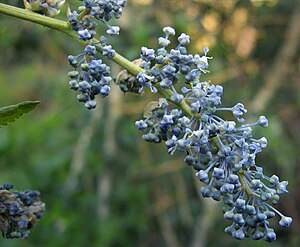Ceanothus leucodermis
| Ceanothus leucodermis | ||||||||||||
|---|---|---|---|---|---|---|---|---|---|---|---|---|

Ceanothus leucodermis |
||||||||||||
| Systematics | ||||||||||||
|
||||||||||||
| Scientific name | ||||||||||||
| Ceanothus leucodermis | ||||||||||||
| Greene |
Ceanothus leucodermis ( English chaparral white thorn, chaparral white thorn ) is a plant from the family of Buckthorn family . This sacflower is an important food source for various types of ungulates such as mule deer and desert bighorn sheep , which prefer the young shoots to the older, thorny sprouts.
description
Ceanothus leucodermis is a thorny shrub up to four meters high. The bark is gray-white, waxy and somewhat hairy, especially on the young shoots. The branches harden into sharp-pointed thorns with age. The evergreen leaves are arranged alternately, oval and about four centimeters long. The margins are smooth or have tiny glandular teeth. They are coated with a delicate white powdered layer that can be rubbed off. The stipules , small leaf-like structures on the petiole , are thin and fall off early compared to other species of the genus.
The inflorescence forms a long-stalked group of flowers in shades of blue, lavender, or white. The fruit is a sticky, three-part capsule about half a centimeter long. Unlike other species of the genus, the fruits have no thorns.
distribution and habitat
Ceanothus leucodermis is native to California and Baja California , where the species lives in the coastal and inland mountains. It inhabits the chaparral , coniferous forests with a temperate climate and oak forests.
ecology
Like all ceanothus species lives Ceanothus leucodermis in symbiosis with air nitrogen-fixing Frankia bacteria, which as actinorhizal plant is called.
Individual evidence
- ↑ a b Ceanothus leucodermis . US Forest Service . Retrieved May 29, 2019.
- ^ A b c Nancy Dale: Flowering Plants of the Santa Monica Mountains , 2nd edition 2000.
- ^ Brian Oakley, Malcolm North, Jerry F. Franklin, Brian P. Hedlund & James T. Staley: Diversity and Distribution of Frankia Strains Symbiotic with Ceanothus in California. In: Applied and Environmental Microbiology , Volume 70, 2004, pp. 6444-6452. doi : 10.1128 / AEM.70.11.6444-6452.2004 .